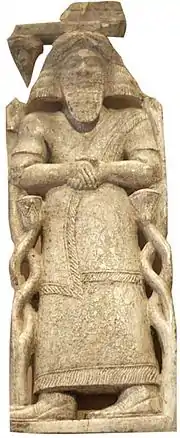Aramean kings
Aramean kings were kings of ancient Arameans, and rulers of various Aramean states that existed in western regions of the Ancient Near East during the 9th and 8th century BC, before being absorbed into the Neo-Assyrian Empire.[1][2]
| Arameans |
|---|
| Syro-Hittite states |
| Aramean kings |
| Aramean cities |
| Sources |
Kings

King Hazael of Aram-Damascus
Aramean kings are known from various inscriptions, and some are also mentioned in the Hebrew Bible.
Aram-Damascus[3]
| Name | Reign | Notes |
|---|---|---|
| Rezin | ca. 960 | |
| Hezion | ca. 960 | son of Rezin |
| Tabrimmon | ca. 930 | son of Hezion |
| Ben-Hadad I | ca. 960 | son of Tob-Rimmon |
| Ben-Hadad II | ca. 930 | son of Ben-Hadad I |
| Ben-Hadad III | ca. 900 | son of Ben-Hadad II |
| Hazael I | 895 - 854 | usurper |
| Ben-Hadad III | 854 - 842 | son of Hazael I, Aramaic Bir-Hadad, Assyrian Adad-idri |
| Hazael | 842 - 824 | son of a nobody, but not a usurper |
| Mari | 824 - 790 | son of Hazael II? |
| Hadyan II | ca. 775? - mid 8th century | Assyrian Hadiiani |
| Azriau | 750 - 740 | Hebrew Azar-Yao/Rezin |
| Raqianu | 740 - 727 | Assyrian Rahianu |
Bit-Agusi[4]
| Name | Reign | Notes |
|---|---|---|
| Gusi | ca. 870 | Dynasty founder |
| Hadram | ca. 860 - 830 | son of Gusi (Arame) |
| Attar-šumki I | ca. 830 - 800/ 805 - 796[5] | son of Hadram, synonym Bar-Guš[5] |
| Bar-Hadad | ca. 800 | son of Attar-šumki I, reign unclear |
| Attar-šumki II | 1st half 8th century | son of Bar-Hadad |
| Mati-Ilu | mid 8th century | son of Attar-šumki II |
Bit-Gabbari (Sam'al)
| Name | Reign | Notes |
|---|---|---|
| Gabbar | ca 920[6]/ca. 900 - 880 | Dynasty founder |
| Bamah | ca. 880 - 865 | son of Gabbar |
| Hayya | ca. 865-840[7] | son of Bamah |
| Ša-il | ca. 840 - 830 | son of Hayya |
| Kilamuwa | ca. 830 - 820[7] | brother of Ša-il |
| Qarli | ca. 820 - 740 | son of Ahabbu?, he unified Sam'al and Y'DY |
| Panamuwa I | ca. 790 - 750 | son of Qarli, synonym Panammu[8] |
| Bar-Sur | ca. 750 | son of Panamuwa I |
| Panamuwa II | ca. 743[9] - 727 | son of Bar-Sur, synonym Panammu[8] |
| Bar-Rakib | 727[10] - 713/711[11] | son of Panamuwa II |
| Bar-Rakib II | 727[12] - 713/711[11] | son of Bar-Rakib |
| Bar-Rakib III | 727[13] - 713/711[11] | son of Bar-Rakib II |
Kasku[14]
| Name | Reign | Notes |
|---|---|---|
| Bar-Ga'ya | mid 8th century | Possibly an Assyrian high official |
Aram-Zobah[15]
| Name | Reign | Notes |
|---|---|---|
| Hadad-ezer | at the time of Saul and David of Israel |
Bit Bahiani [15]
| Name | Reign | Notes |
|---|---|---|
| Kapara | 950-875 BC | He built a monumental palace in Neo-Hittite style discovered by Max von Oppenheim in 1911, with a rich decoration of statues and relief orthostats |
Hamath[15]
| Name | Reign | Notes |
|---|---|---|
| Irhuleni | 853 BC | He led a coalition against the Assyrian expansion under Shalmaneser III, alongside Hadadezer of Damascus.[16] |
Aram-Naharaim[15]
| Name | Reign | Notes |
|---|---|---|
| Cushan-rishathaim | 1250 BC | He was king of Aram-Naharaim, or Northwest Mesopotamia, and the first oppressor of the Israelites after their settlement in Canaan. |
See also
| Wikimedia Commons has media related to Aramean kings. |
References
- Lipiński 2000.
- Younger 2016.
- Bryce (2012), pp. 175–178, 309.
- Bryce (2012), pp. 165–168, 308.
- Leick (2002), p. 33.
- Leick (2002), p. 60.
- Leick (2002), p. 92.
- Leick (2002), p. 128.
- Alessandra Gilibert: Syro-Hittite Monumental Art and the Archaeology of Performance. Berlin 2011, p. 135.
- Alessandra Gilibert: Syro-Hittite Monumental Art and the Archaeology of Performance. Berlin 2011, p. 135.
- Leick (2002), p. 38.
- Alessandra Gilibert: Syro-Hittite Monumental Art and the Archaeology of Performance. Berlin 2011, p. 135.
- Alessandra Gilibert: Syro-Hittite Monumental Art and the Archaeology of Performance. Berlin 2011, p. 135.
- Bryce (2012), p. 179.
- Bryce (2012), pp. 179–180.
- Luis Robert Siddall, The Reign of Adad-nīrārī III: An Historical and Ideological Analysis of An Assyrian King and His Times. BRILL, 2013 ISBN 9004256148 p.37
Sources
- Gzella, Holger (2015). A Cultural History of Aramaic: From the Beginnings to the Advent of Islam. Leiden-Boston: Brill.
- Lipiński, Edward (2000). The Aramaeans: Their Ancient History, Culture, Religion. Leuven: Peeters Publishers.
- Sader, Hélène (2014). "History". The Aramaeans in Ancient Syria. Leiden: Brill. pp. 11–36.
- Younger, Kenneth Lawson (2016). A Political History of the Arameans: From Their Origins to the End of Their Polities. Atlanta: SBL Press.
External links
This article is issued from Wikipedia. The text is licensed under Creative Commons - Attribution - Sharealike. Additional terms may apply for the media files.